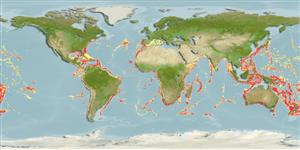Common names from other countries
Environment: milieu / climate zone / depth range / distribution range
Écologie
; profondeur 274 - 1850 m (Ref. 101581), usually 400 - 900 m (Ref. 8). Tropical, preferred 25°C (Ref. 107945); 43°N - 48°S, 97°W - 138°W (Ref. 113739)
Circumglobal in tropical to temperate waters.
Length at first maturity / Taille / Poids / Âge
Maturity: Lm ? range ? - ? cm Max length : 19.3 cm TL mâle / non sexé; (Ref. 8); 33.4 cm TL (female)
Commercially fished in the Atlantic (Senegal, Guinea, Congo, Angola, and French Guyana) (Ref. 8), but no longer in Brazil (Ref. 101581). Benthic (Ref. 91956). Predominantly deep-water species (Ref. 104150). Found on muddy bottom. Temperate to tropical environment (Ref. 8). Feeds on crustaceans, sediment, fishes, cephalopods, anthozoans, polychaetes and echinoderms (Ref. 104150).
Life cycle and mating behavior
Maturité | Reproduction | Frai | Œufs | Fécondité | Larves
Members of the order Decapoda are mostly gonochoric. Mating behavior: Precopulatory courtship ritual is common (through olfactory and tactile cues); usually indirect sperm transfer.
Holthuis, L.B. 1980. (Ref. 8)
Statut dans la liste rouge de l'IUCN (Ref. 130435)
statut CITES (Ref. 108899)
Not Evaluated
Not Evaluated
Utilisations par l'homme
Pêcheries: commercial
| FishSource | Sea Around Us
Outils
Sources Internet
Estimates based on models
Preferred temperature
(Ref.
115969): 3.7 - 12.6, mean 7.4 (based on 1390 cells).
Vulnérabilité
Low vulnerability (10 of 100).
